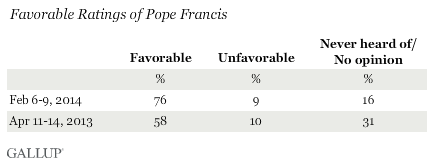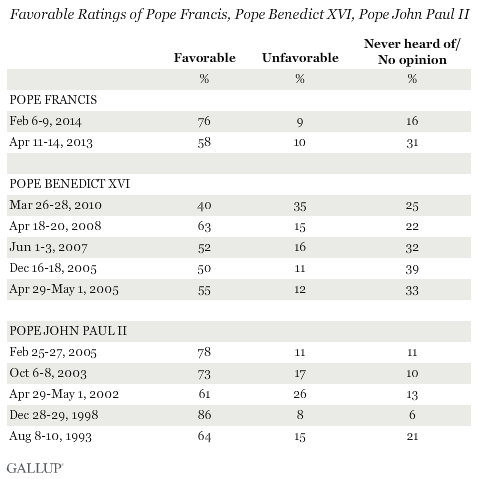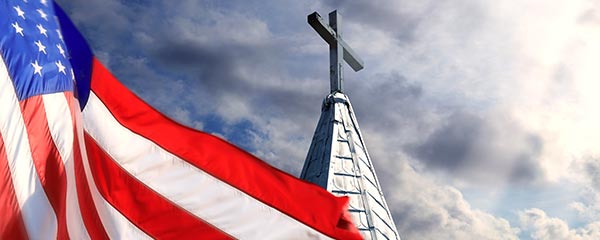PRINCETON, NJ -- President Barack Obama meets Thursday for the first time with Pope Francis, whose image among Americans has become more favorable over the first year of his papacy. More than three in four Americans currently view the pope favorably.

Obama and Pope Francis, meeting at the Vatican, are expected to focus on the concerns both men have about inequality and the rising gap between rich and poor in the world today. Obama might well hope to benefit from his association with the popular pope. In the same February poll in which Pope Francis received his 76% favorable, 9% unfavorable rating from Americans, Obama's image was much more divided, at 52% favorable and 46% unfavorable.
A Gallup survey conducted the month after Pope Francis' election on March 13, 2013, showed that Americans' initial impressions of him were positive, although more than three in 10 had never heard of him or didn't have an opinion. As he has become better known over the past year, including being named TIME's Person of the Year in December, Pope Francis' favorable rating has increased. His low unfavorable percentage has remained essentially constant.
Pope Francis was elected after Pope Benedict XVI resigned in February 2013. Benedict ended his papacy in a significantly less popular position among Americans than when he was elected in 2005. At his most popular, in 2008, Benedict had a 63% favorable, 15% unfavorable rating in the U.S. But by 2010, dogged by his handling of the priest abuse scandals both before and after he became pope, nearly as many Americans saw Benedict unfavorably as favorably.

In contrast with Benedict, his predecessor, Pope John Paul II, had a highly favorable image among Americans from the time Gallup started measuring his rating in 1993. John Paul averaged a 72% favorable rating; his highest rating was 86% in December 1998 and his lowest was 61% in late April/early May 2002.
Catholics Highly Positive, but So Are Other Americans
Pope Francis enjoys the highly positive ratings that would be expected among American Catholics, but Protestants -- the largest religious group in the U.S. -- also see him in a favorable light. More than seven in 10 of those who do not claim an official religious identity also view Pope Francis favorably.

American Catholics' views of Francis are similar to their views of Pope John Paul II in the February 2005 survey conducted just before his death. At the time, 93% rated John Paul II favorably, and 4% unfavorably. By contrast, Catholics gave Pope Benedict a significantly lower 61% favorable rating in 2010.
Bottom Line
About one year after he was elected pope, Americans are essentially as positive about Francis as they were about Pope John Paul II shortly before he died. By contrast, Pope Benedict's image had deteriorated to a much less positive position in the years before he resigned in 2013.
Survey Methods
Results for this Gallup poll are based on telephone interviews conducted Feb. 6-9, 2014, with a random sample of 1,023 adults, aged 18 and older, living in all 50 U.S. states and the District of Columbia.
For results based on the total sample of national adults, the margin of sampling error is ±4 percentage points at the 95% confidence level.
Interviews are conducted with respondents on landline telephones and cellular phones, with interviews conducted in Spanish for respondents who are primarily Spanish-speaking. Each sample of national adults includes a minimum quota of 50% cellphone respondents and 50% landline respondents, with additional minimum quotas by time zone within region. Landline and cellular telephone numbers are selected using random-digit-dial methods. Landline respondents are chosen at random within each household on the basis of which member had the most recent birthday.
Samples are weighted to correct for unequal selection probability, nonresponse, and double coverage of landline and cell users in the two sampling frames. They are also weighted to match the national demographics of gender, age, race, Hispanic ethnicity, education, region, population density, and phone status (cellphone only/landline only/both, and cellphone mostly). Demographic weighting targets are based on the most recent Current Population Survey figures for the aged 18 and older U.S. population. Phone status targets are based on the most recent National Health Interview Survey. Population density targets are based on the most recent U.S. census. All reported margins of sampling error include the computed design effects for weighting.
In addition to sampling error, question wording and practical difficulties in conducting surveys can introduce error or bias into the findings of public opinion polls.
View survey methodology, complete question responses, and trends.
For more details on Gallup's polling methodology, visit www.gallup.com.
